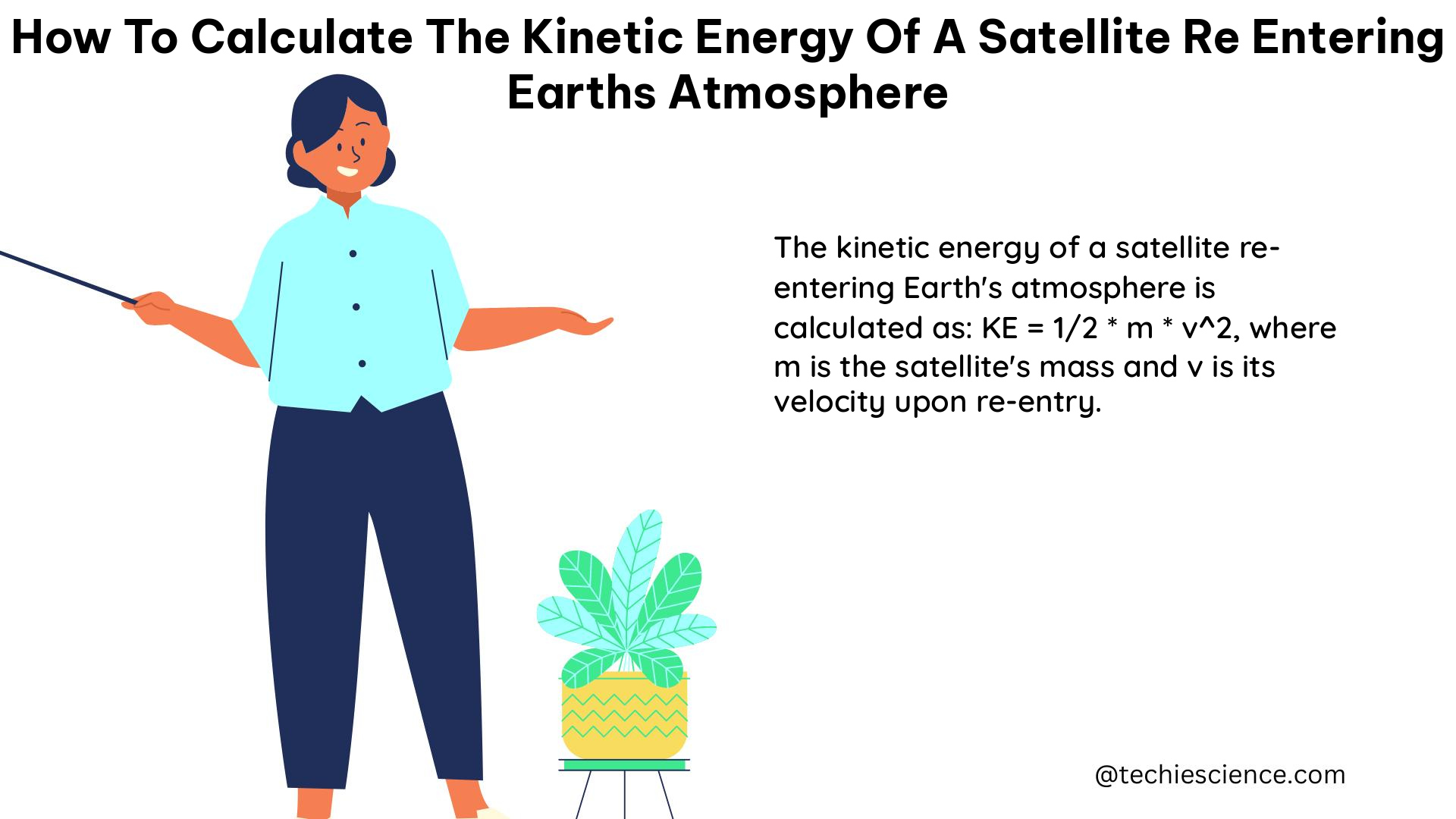The kinetic energy of a satellite re-entering Earth’s atmosphere is a crucial factor to consider, as it determines the amount of energy the satellite will release upon re-entry. This energy can lead to the destruction of the satellite due to the intense heat generated by the friction between the satellite and the atmosphere. To calculate the kinetic energy of a satellite re-entering Earth’s atmosphere, we need to understand the underlying physics principles and formulas.
Understanding Satellite Orbits and Kinetic Energy
Satellites orbiting the Earth are subject to the gravitational force exerted by the planet. The velocity of a satellite in a circular orbit is determined by the balance between the centrifugal force and the gravitational force. This velocity, in turn, determines the kinetic energy of the satellite.
The formula for the velocity of a satellite in a circular orbit is:
v = sqrt(GM/r)
where:
– v is the velocity of the satellite (in m/s)
– G is the gravitational constant (6.67 × 10^-11 N⋅m^2/kg^2)
– M is the mass of the Earth (5.97 × 10^24 kg)
– r is the radius of the satellite’s orbit (in m)
The kinetic energy of the satellite is then calculated using the formula:
K.E. = (1/2) * m * v^2
where:
– K.E. is the kinetic energy of the satellite (in Joules)
– m is the mass of the satellite (in kg)
– v is the velocity of the satellite (in m/s)
Calculating the Kinetic Energy of a Satellite Re-Entering Earth’s Atmosphere

Let’s consider an example to illustrate the calculation of the kinetic energy of a satellite re-entering Earth’s atmosphere.
Suppose we have a satellite with a mass of 1000 kg in a circular orbit with a radius of 7000 km (7,000,000 m).
First, we calculate the velocity of the satellite using the formula:
v = sqrt((6.67 × 10^-11 N⋅m^2/kg^2) * (5.97 × 10^24 kg) / (7,000,000 m))
v = 7,669.6 m/s
Now, we can calculate the kinetic energy of the satellite using the formula:
K.E. = (1/2) * 1000 kg * (7,669.6 m/s)^2
K.E. = 2.85 × 10^11 Joules
Therefore, the kinetic energy of the satellite in this example is 2.85 × 10^11 Joules.
Factors Affecting Kinetic Energy During Re-Entry
As the satellite re-enters the Earth’s atmosphere, its velocity will increase due to the drag caused by the atmosphere. This increase in velocity will result in a corresponding increase in the satellite’s kinetic energy.
The factors that can affect the kinetic energy of a satellite during re-entry include:
- Satellite Mass: The mass of the satellite directly affects its kinetic energy. Heavier satellites will have higher kinetic energy.
- Satellite Velocity: The velocity of the satellite is the most significant factor in determining its kinetic energy. As the satellite’s velocity increases during re-entry, its kinetic energy will increase exponentially.
- Atmospheric Drag: The drag force exerted by the Earth’s atmosphere on the satellite can significantly affect its velocity and, consequently, its kinetic energy.
- Satellite Orientation: The orientation of the satellite during re-entry can impact the amount of atmospheric drag it experiences, which can affect its kinetic energy.
- Satellite Design: The design of the satellite, including its shape and materials, can influence the amount of heat generated during re-entry, which can affect the kinetic energy.
Numerical Examples and Calculations
To further illustrate the calculation of kinetic energy for satellites re-entering the Earth’s atmosphere, let’s consider a few numerical examples.
Example 1:
– Satellite mass: 500 kg
– Satellite velocity at re-entry: 8,000 m/s
– Kinetic energy = (1/2) * 500 kg * (8,000 m/s)^2 = 1.6 × 10^11 Joules
Example 2:
– Satellite mass: 800 kg
– Satellite velocity at re-entry: 9,500 m/s
– Kinetic energy = (1/2) * 800 kg * (9,500 m/s)^2 = 3.62 × 10^11 Joules
Example 3:
– Satellite mass: 1,200 kg
– Satellite velocity at re-entry: 10,000 m/s
– Kinetic energy = (1/2) * 1,200 kg * (10,000 m/s)^2 = 6 × 10^11 Joules
These examples demonstrate how the kinetic energy of a satellite re-entering the Earth’s atmosphere can vary significantly depending on the satellite’s mass and velocity.
Conclusion
Calculating the kinetic energy of a satellite re-entering the Earth’s atmosphere is crucial for understanding the potential risks and challenges associated with this process. By using the formulas and principles outlined in this blog post, you can accurately determine the kinetic energy of a satellite and gain valuable insights into the dynamics of satellite re-entry.
Remember, as the satellite’s velocity increases during re-entry, its kinetic energy will also increase, leading to the generation of intense heat and potential destruction of the satellite. Understanding these concepts can help engineers and scientists design more robust and safer satellite systems for re-entry.
References:
- Energy of An Orbiting Satellite – Vedantu: https://www.vedantu.com/physics/energy-of-an-orbiting-satellite
- Problem 56 A satellite is in a circular orbit around a planet – Vaia: https://www.vaia.com/en-us/textbooks/physics/university-physics-with-modern-physics-1-edition/chapter-12/problem-56-a-satellite-is-in-a-circular-orbit-around-a-plane/
- How Much Energy is Required to Change the Orbit of a Satellite? – YouTube: https://www.youtube.com/watch?v=k30LTXOQ4-M
- Calculating the Kinetic Energy of a Spacecraft in a Circular Path around Earth Physics – Nagwa: https://www.nagwa.com/en/videos/360161310368/
- 13.5: Satellite Orbits and Energy – Physics LibreTexts: https://phys.libretexts.org/Bookshelves/University_Physics/University_Physics_%28OpenStax%29/Book:_University_Physics_I_-_Mechanics_Sound_Oscillations_and_Waves_%28OpenStax%29/13:_Gravitation/13.05:_Satellite_Orbits_and_Energy

The lambdageeks.com Core SME Team is a group of experienced subject matter experts from diverse scientific and technical fields including Physics, Chemistry, Technology,Electronics & Electrical Engineering, Automotive, Mechanical Engineering. Our team collaborates to create high-quality, well-researched articles on a wide range of science and technology topics for the lambdageeks.com website.
All Our Senior SME are having more than 7 Years of experience in the respective fields . They are either Working Industry Professionals or assocaited With different Universities. Refer Our Authors Page to get to know About our Core SMEs.